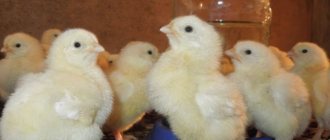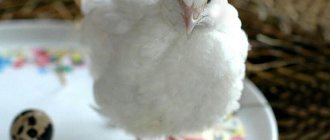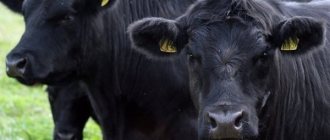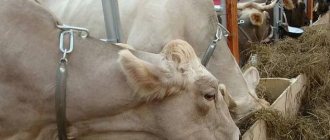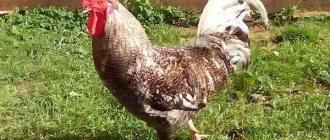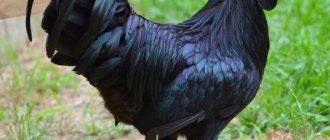The article is devoted to pigs of the Karmal breed, which today are the subject of very widespread and often unfair advertising. We will try to understand the extremely confusing terminology and help readers understand whether they should breed these animals.
Karmals are widespread in the post-Soviet space and are of great interest to many novice pig farmers
The history of the hybrid
Karmals appeared as a result of crossing two breeds of pigs: the Korean herbivore and the Mangalitsa. This hybrid took all the best qualities from its ancestors:
- animals rarely get sick;
- they have a large mass and grow quickly;
- insensitive to cold and heat;
- unpretentious in food;
- a sow gives birth to many piglets at once (about 22);
- Karmals are very kind and curious, not aggressive at all.
There are two types of pockets: regular and royal. The regular one appeared by mating a Vietnamese boar and a Korean pig, while the royal one was formed in a more complex way. Piglets of this breed appeared only after a generation. So, first the Mangalitsa mated with a Korean boar, and then, when their piglets were born and grew up, they were crossed with Vietnamese boars. The meat of this hybrid is considered a delicacy and its cost is much higher than usual.
Pros and cons of the breed
Karmaly pigs have many advantages:
- strong immunity, no need for vaccinations (but it is important to carry out anthelmintic prophylaxis);
- resistance to cold, making it possible to keep animals in open pens;
- unpretentiousness in food;
- early puberty and good fertility;
- calm disposition;
- cheap maintenance and inexpensive feeding;
- large quantity and excellent quality of gourmet meat.
Among the disadvantages of pigs of this breed are the splitting of traits during breeding (towards barbecues or Asian) and sensitivity to drafts.
Description and features of the hybrid
As we noted above, karmals are very kind, they have absolutely no aggression, and they do not attack other pigs or people, and do not harm birds.
Karmal pigs are large, with a wide chest and thick curly hair. The color of a newborn piglet is usually black, red or gray, with stripes. The thick coat helps the karmals survive even in very cold climates. In severe frosts, these pigs willingly play in the snow and do not freeze.
Young piglets have long legs. They are very curious and active. As adults, pigs and wild boars are not as fat as other breeds; they look quite graceful.
Karmal pigs have large hams, a short but strong neck, also strong legs, a muzzle extended forward, and small ears.
Pigs are very neat and well behaved. You need to leave a place for them to walk with a regular fence, since they do not want to escape to freedom and do not make tunnels.
Karmals produce meat to a greater extent. They have a wide back, rump and chest. The productivity of pigs depends on what type of pigs you breed. So, ordinary ones weigh about 150 kg at one and a half years, and royal ones - up to 220 kg.
Measurements and weighing of a male karmal at 11 months were carried out in the following video:
Main characteristics
In the situation with Karmals, it is difficult to identify general characteristics, since official breed standards simply do not exist. Here is the data collected from reviews of livestock breeders and descriptions of breeders:
| Parameter | Characteristic |
| Animal | Pig |
| Breed (hybrid) | Karmal |
| Productive type | Meat |
| Live weight of adults | On average 200-220 kg |
| Age of puberty in pigs | 4-6 months |
| Multiple pregnancy | From 12 to 22 per farrowing |
| Suit | Black, ash or brown (red and spotted are also found) |
| Bristle | Quite long, dense, sometimes curly |
| Color of the skin | White |
| The period of gaining slaughter weight is 150 kg | 18 months |
| Meat quality | High |
| Meat yield from carcass | Up to 85% |
| Disease resistance | High |
| Registration in the State Register of the Russian Federation | Not included |
Advantages and disadvantages
As we wrote above, karmals have many advantages, which makes them quite popular in agriculture. In addition to the advantages already described, there are also the following:
- High survival rate of pig offspring.
- Sows take good care of their piglets.
- The thick curly coat of the Karmals protects them from the cold.
- Pigs eat any food: dry, steamed, juicy.
- These pigs have a lot of meat with a thin layer of fat. It tastes much better than regular pork, as it is very tender and juicy.
Breeding karmals is very profitable from a financial point of view. The costs of buying a pig and caring for it pay off in the first year.
Unlike other breeds of pigs, you do not need to spend a lot of money on buying expensive feed, building a special pigsty with heating, and there is practically no need to treat the piglets, since they have a very strong immune system.
By selling karmal meat, you will get much more profit than by selling regular pork. Therefore, choosing this type of pig will bring you much better results.
Despite the advantages, there are also disadvantages. Due to the fact that the breed is a hybrid, the characteristics of subsequent offspring are split. Simple Karmals may produce piglets that are exactly similar to Asian Folds, but it is also quite possible to get a piglet that is almost 100% of the Mangal breed.
Owner reviews
Svetlana, 38 years old, Yelets
At the beginning of summer I bought a couple of month-old female karmals. I wanted to try to get offspring from them, fortunately, the neighbors have an adult barbecue boar. At the time of purchase, my little pigs were almost identical, differing only in color. The seller claimed that they were from the same farrow. Now the pigs are 5 months old, and the black one is noticeably larger than the gray one, although I feed them the same, and their constitution is very different. Both are fast and quite noisy. They don’t bite, don’t get sick, and love grass very much. I was told that they can eat dry feed, but I still make wet mash. The pigs spend almost all their time walking (in an enclosure); they only come to the barn to sleep. They are not digging under the fence, but the wooden panels in the pigsty have been thoroughly chewed. In general, everything would be fine, but I have great doubts about their future. If piglets from one litter have such a range of qualities, what will happen to their offspring? I’ll still try to make them with the grill. Maybe something worthwhile will come out, otherwise it’s a shame for the money spent.
Igor, 54 years old, Tver region
In my opinion, this breed is greatly overpraised. I took the pocket to try three years ago. Apart from his peaceful character, love for walks and the ability to eat all the greenery in a row, I didn’t notice any other advantages. The pig grew very slowly, although it was bursting from the belly. By 8 months she weighed a little more than 70 kg. She had problems digesting grains (even in the form of crushed porridge): almost everything ended up in the litter. The meat after slaughter turned out to be lean and tasty, it’s a pity that there was only a little of it. It turns out that either the information about the breed is not very true, or the seller slipped me a pig of a different variety. Of course, I would like to have exotic meat miracle pigs, unpretentious, economical, etc. But, apparently, we will have to wait until the young animals appear on breeding farms. I won’t buy any more from my own hands: piglets are expensive, and the result does not live up to expectations.
Maxim, 40 years old, Ternopil
I liked the Karmal pigs. I took both regular and royal ones. I fed them on natural food and grew up to 300 kg. They are not capricious in care and feeding. Omnivores, practically do not get sick even without vaccinations, sows give birth on their own without any help. They are not afraid of heat and cold; by winter the coat becomes longer and thicker.
Care and conditions of detention
For Karmal pigs, it is necessary to make a walking area with a fence. There is no need to worry about the animals breaking the fence and running away, this breed is very neat and friendly. Sometimes they stand on their hind legs at the fence just to see what is happening behind it: carmals are very curious.
These pigs are family pigs; they love to always be close to their relatives. Karmals usually choose the leader of their herd. Therefore, in order to drive animals into the barn, you must first send a leader there.
Feeders and drinking containers should be installed in the pig pen. And in the summer, karmals should have access to fresh grass. In addition, it should be remembered that these pigs do not like dirt, so a tank with water for bathing the animals must be installed in the place where they are kept.
Necessary conditions for keeping individuals of this hybrid:
- In winter, pigs need to walk; thanks to their fur, they will not freeze.
- An ordinary wooden barn is suitable for keeping pigs, but it is better to keep piglets in a building where there are no drafts.
- Karmals sometimes get parasites, despite their strong immunity. You just need to follow preventive measures. They are also vaccinated against viral infections (depending on the region).
- When piglets are two months old, they are castrated.
Nutrition selection
These hybrid animals are unpretentious to food. In summer, they can stay on the pasture all day and eat grass. They love it when oak trees grow in the area. These animals collect acorns, which are usually sufficient in August and September. They look for them in the grass.
Karmals are smart animals. If they don't find their favorite treat, they surround the tree and push it until acorns begin to fall from the oak tree. If there are no oak trees in the area, pigs find an alternative. These could be wild apple trees. They happily eat them. Livestock can be supplemented with vegetables and cereals in the summer.
Karmals love to eat, and therefore extra food intake is not harmful for them. In order for individuals to gain weight well, it is necessary to offer them crushed grain, food waste, vegetables, animal feed and cereal porridge. Karmals are very fond of fodder and sugar beets. Even if the nutrition is quite intensive and involves the use of yeast in large quantities, the animals do not form a thick layer of fat.
Karmal meat is tender, has minimal fat content and is quite juicy. One of the most profitable breeds for farmers is Karma pigs. They are resistant to any disease. Their maintenance is much more profitable than raising ordinary families. At the same time, karmals produce large offspring. Their wool can be used to produce yarn, which can provide an additional source of income for the farm.
Feeding the pockets
Almost any food is suitable for karmals: porridge, potatoes, beets, silage, food waste. Karmals, unlike other breeds, need much less special feed and feed. So, for an adult pig, feed should be no more than 70% of the total daily ration, then its meat will be tasty.
In addition, karmals are very fond of grass from the garden or meadow, so it is necessary to give it to pigs, especially in summer.
The diet of these animals may also contain raw or boiled vegetables, apples, acorns and grains. Due to the fact that the Karmals had herbivores in their family, feeding pigs with expensive feed is completely useless, and in some cases even harmful. To improve the taste and smell of pork, fresh herbs and dairy products are added to the animals' food.
Despite their unpretentiousness in food, it is extremely undesirable to give fishmeal and soy to karmals. Since this will lead to a deterioration in the quality of meat.
Young piglets can be given soft grass as early as two weeks of age. And with the 3rd, you can add porridge and grated carrots to your diet. From the beginning of the fourth week, boiled potatoes are allowed to be included in the menu. It is also worth adding adult food a little at a time, but this must be done only in the correct ratio: 5% fish (make sure there are no large bones), 5% legume flour, 20% vegetables and 70% feed.
In addition, it is also important to observe the sequence of introducing adult food into the diet. So, the first to add are vegetables, ground into puree: carrots, beets and pumpkin, then porridge, then boiled ground potatoes and after that - food.
It is also important for pigs to have enough calcium in their diet, as it improves immunity and builds bones. But ordinary food does not contain enough calcium. Therefore, experts suggest adding feed chalk to the diet of karmals. It contains about 38% calcium, which helps pigs to be healthy, improves metabolism and increases reproduction, and in young piglets it also prevents the development of rickets.
However, when using such a supplement you should also know when to stop: the norm depends on the health of the animal, its age and size. On average, one adult pig is given 20 grams of chalk per day.
Description of the Karmaly pig breed
Pig farmers speak enthusiastically about the characteristics of Karmal pigs. According to them, the pets inherited the best properties of their Hungarian and Asian ancestors. Like the Hungarian Mangalitsa, Karmals have dense wool, which allows them to free-graze all year round. From pot-bellied and herbivorous “Asians” they adopted a healthy maternal instinct, prolific fertility, friendly disposition and rapid weight gain on succulent green food.
According to the descriptions of pig breeders, karmals are an ideal pig with excellent qualities such as:
- omnivorous;
- good health and frost resistance;
- good immunity;
- peaceful character;
- multiple births;
- rapid puberty;
- the possibility of subsequent fertilization a month after farrowing;
- a small percentage of fat in meat.
The appearance reflects a bizarre mixture of European and Asian roots:
- shortened head of medium size;
- short wide neck;
- large short snout;
- White skin;
- the body is short, barrel-shaped;
- back without pronounced deflection;
- slightly sagging belly;
- short strong legs.
The animals have long fur with a thick undercoat of brown, black or gray color. Sometimes there are red, striped or spotted individuals.
Gilts are almost the same in weight as boars. The weight of an adult pig is 190–230 kg.
How to choose piglets when purchasing?
The best time to buy piglets is spring, since during this period it is possible to feed the piglet grass and vegetables.
When choosing a pig, you need to be careful and pay attention even to small details:
- The animal's chest should be wide, its back straight, its legs strong and long, its hooves should be shiny, and its ears should be small and pink.
- The tail should be dry and not adjacent to the body; it is usually curled into a ring.
- Even a very small pig should not be bald; it is covered with thick hair, most often striped. No bald spots on the animal's body are allowed.
- Make sure that the karmal's eyes react to your movements; they should shine brightly.
- The piglet should be very active and slightly fussy, this indicates its good health.
- A piglet's head is usually heavy, which means the pig will be precocious.
- When choosing a piglet, you need to feed it and see how it eats. The animal must eat quickly and with appetite.
- The piglet's two jaws must be the same size, otherwise the animal will not eat well.
- Do not think that a fat big pig at a small age is a good choice. Most likely, he was specially fed with milk with added sugar to prepare him for sale. Such a pig will not want to eat regular food, but only sweets.
- If you pick up a piglet, it should squeal loudly. If his cry is quiet and muffled, then this indicates that the animal is weakened or has diseases.
Features of the acquisition
Where and how to buy
If you buy pigs from trusted sellers who have barbecues and Korean ones, the offspring may turn out differently. Even if you take piglets from different litters and cross them with each other, there may be no result.
It is better to breed Karmalov in the first generation. Buy original breeds and cross them yourself.
The sow brings multi-colored piglets: from black and red to ash and white with stripes. This is the “calling card” of the Karmals.
Visual inspection
Before purchasing, you need to carefully inspect the piglets. In healthy animals, the tail does not weigh or stick to the body, but sticks out and curls. No wheezing is heard when breathing. There is no discharge from the heel, ears or cloaca.
The piglet must have the correct bite. If your animal has dental problems, it is difficult to chew food. As a result, weight gain falls and disruptions occur in the gastrointestinal tract. A fatal outcome cannot be ruled out.
Already by a month, young karmals are covered with wool. Hairless piglets are either a different breed or are sick.
The seller must have certificates that confirm the hybrid origin of the karmals.
When to buy
In order for karmals, like a breed of pigs, to be beneficial, it is better to buy them at 1-2 months. The digestive system of piglets at this age is already ready to digest adult food. Grown-up young animals are less susceptible to diseases.
The best time to purchase karmal piglets is spring, when there is plenty of pasture.
How to breed karmals?
Karmals can be bred in any region and under any climatic conditions, as they are resistant to cold, heat and various diseases. Pigs can easily and happily spend the whole day in the cold, playing in the snow, and not catch a cold from it. All this is thanks to their thick fur, which they got from the barbecue.
Karmals mature at 4 months, but it is better to mate them at about 7-8 months. It is thanks to this property that karmals are considered the leader of fertility. Pregnancy in this hybrid lasts about 4 months. After giving birth, the pig does not need human help. Karmals are very smart and take good care of their offspring. The only thing you need to do is build a small structure for the piglets in the pigsty.
A sow can give birth to piglets with different colors. So, in a brood there may be young animals from black to reddish colors with bright stripes.
The offspring of Karmals always produces more females than males.
After giving birth, the female has a lot of milk, which is enough for all the piglets. From birth, they develop immunity to various diseases, and the piglets are also very active.
As soon as the pig has given birth to piglets, within a month she is again ready for mating and the appearance of another offspring. Thanks to this feature, karmals are a constant source of meat and, as a result, income for farmers.
To breed these pigs, it is enough to have only one boar. However, it should be remembered that males reach puberty a little later than females.
Karmal boars can also be mated with pigs of other breeds in order to improve their quality characteristics.
You can see what one-month-old piglets look like, what size they are, and what color they may have in the video:
Intended (desired) features of the “breed”
According to most sources, the characteristics of Karmal piglets and adults are a combination of the best properties they inherited from their Asian and Hungarian “parents”. From the former, the hybrids received multiple births, excellent maternal qualities, a calm character, the ability to build muscle mass, eating mainly succulent feed and grass, and from the latter, a warm coat that allows them to live free-range in any weather, and good health.
It is difficult to judge the appearance of a breed from a photo - the photographs are too varied
Judging by the descriptions, these are quite large animals that have an elongated body, short, strong legs, a wide chest and a massive sacrum. The back is straight or slightly concave, the belly is very saggy. The head is small, the snout is elongated, and the neck is thick. The ears are small and erect. The bristles are more like wool, quite long, dense, and sometimes curly. The color of adult pigs is black, ashy or brown (according to other sources, there are red and spotted individuals). The skin color of all pockets is white. The average weight of sows and boars is approximately the same and is 200-220 kg .
Representatives of the breed mature very early. Pigs are able to mate from 4 months, and by 8 months, in most cases, they already give birth . The sow gives birth with virtually no problems and takes excellent care of the young. Females have a lot of milk. There is enough food for all the piglets, even if the “nest” is very prolific. For each farrowing there are from 12 to 22 babies. Piglets are born strong and healthy, although small.
A characteristic feature is the heterogeneity of the “nest” in color: in one farrow there are black, gray and reddish babies, as well as striped and spotted
With age, the color of the “coat” of newborn piglets changes, and the pigs gradually acquire a uniform adult color. Young animals do not grow very quickly: pigs reach the optimal weight for slaughter of 150 kg only by one and a half years .
Piglets begin to be switched to adult feed at a very early age. From the 7th day of life they give crushed grass, from the 14th they begin to introduce liquid porridge into the diet. Month-old babies are taken away from the sow, who by this time is already ready for a new mating. An adult female can give birth to up to 50 piglets per year .
The quality of karmal meat is rated very highly. Connoisseurs believe that this pork tastes similar to veal. The fat layers in muscle mass are very thin, as is the layer of subcutaneous fat. The meat yield from the carcass is about 85% . Moreover, more than half of the animal’s diet can consist of succulent feed and green mass. If you have free range and home-grown vegetables, fattening piglets is considered quite profitable.
Caring for piglets
The young offspring of karmals do not require any special conditions or care. But if you feed piglets correctly and in a balanced manner, their meat will ultimately be tasty and juicy.
If piglets eat only grains and vegetables, their meat will be tasteless. If you give fish to young animals, the meat may smell like fish. Soy, fish meal and cake also greatly degrade the taste of pork. While dairy products, on the contrary, will make the meat tasty, juicy, and the pig will be healthy and grow faster.
Before the cold weather sets in, little piglets need vitamin and mineral supplements in their feed. But in order to choose the right dosage, discuss this with a specialist.
Newborn piglets do not need to be vaccinated against infections due to their high immunity. However, these measures must be taken when they reach puberty. Karmals also need to undergo anthelmintic treatment. After all, worms in these animals lead to weight loss and allergies. And many types of helminthiasis can even be transmitted to humans. Therefore, taking preventive measures is simply necessary. Medicines for this come in the form of injections, powder and solutions.
If you purchased the product in powder or suspension, mix it with the food, then dilute it a little with water and place it in feeding areas. On the day of this procedure, the amount of food should be reduced by a third. For small piglets, you can dilute the food with the drug with milk or broth. Weaker piglets are best fed separately, in a group of up to 30 piglets. The remaining animals should be dewormed individually.
Sometimes pigs may vomit during this procedure. To prevent this, do not give water to animals before and after the procedure. You can feed after deworming 7 hours later.
Do not give pigs medicine on the tongue, as this will greatly reduce the effect of the drug. And besides this, there is a possibility of it getting into the lungs, which can cause the piglet to die.
Experts also advise adding machine oil to the tank for bathing piglets; it will protect the animals from many diseases.
Subtleties of raising and fattening piglets
Adult sows give birth to from 10 to 22 piglets. The cubs are born small but strong. They actively suck and are very mobile.
Karmals can have piglets of any color in one litter - black, gray, striped, spotted, sandy.
By about a month, the stripes disappear and the pigs acquire a color corresponding to the breed.
Feeding and caring for Karmal piglets differs little from other herbivorous breeds. Starting from the second week of life, babies are offered fresh, finely chopped grass. Mineral supplements - charcoal or red clay - are placed in a separate feeder. The water in the drinking bowl is changed regularly.
By the age of two weeks, they are gradually accustomed to liquid porridges cooked in water or skim milk. Then boiled vegetables are added to the diet. First they are wiped, then cut into small pieces. In the summer, there should be plenty of grass and greenery.
All uneaten food from the trough must be removed, and the dishes must be washed with hot water and soda. Digestion in piglets is very gentle, since hydrochloric acid is not yet formed in the stomach.
At the age of 1 month, babies are transferred to a separate room. By this time the sow is already ready for the next mating.
For rapid growth, piglets are given thick porridge - barley, oatmeal, pea. Supplement with whey, whole or skim milk, kitchen waste, various vegetables and fruits. In winter, hay, hay dust, and silage are added to the diet.
From the age of three months, pigs are given concentrated feed containing bone and fish meal. Boiled potatoes, beets, and carrots are useful vegetables. By 4 months of age, piglets should be eating all types of feed.
Taste characteristics of lard and meat
The meat of karmalov pigs tastes like tender veal. Pork contains thin layers of lard, which makes it the perfect bacon.
The fat layer on the meat of karmals is small and can be easily separated from the meat. The skin of the lard is soft and thin, white in color. The meat of piglets is very soft and flexible, as well as tasty and aromatic.
Karmal meat contains a huge amount of B vitamins, as well as many vital minerals and amino acids. Every 100 grams of pork obtained from this hybrid contains 66% histidine, 44% valine, 52% threonine and tryptophan. This is what makes karmal meat not only incredibly tasty, but also beneficial for the human body.
Raising and breeding this hybrid of pigs on a farm, like karmals, is a very profitable solution, since you can get tasty meat for yourself and for sale, the price of which is much higher than the cost of ordinary pork. At the same time, due to the unpretentiousness of this type of pig, you will not spend all your income on their maintenance.
0
0
Copy link
What to do if piglets grow poorly
As a rule, farmers and breeders of karmals are satisfied with the growth and weight gain of their piglets. However, if a pig farmer still faces this problem, first of all he needs to reconsider the way he feeds his pigs. As already mentioned, for piglets to actively grow, their diet must be balanced and varied. With proper nutrition, young animals gain weight of 80-120 kg by 8 months.
If the piglet is not growing well due to lack of appetite, accompanied by any other painful symptoms (for example, lethargy, etc.), then the animal should be shown to a veterinarian (illnesses in karmala are rare).
Reproduction
Puberty in females of the large white breed occurs in the sixth month of life, but in order to avoid problems with pregnancy and childbirth, it is recommended that they occur no earlier than ten months of age. It is also not recommended to use in breeding queens whose weight has not yet reached 120 kg.
The calm nature of the breed makes the sows excellent for artificial insemination. When choosing this method, you can not keep breeding boars, but order seed material from nurseries and large pig breeding farms.
The onset of a favorable time for fertilization can be determined by several signs:
- Behavior. The female becomes restless and squeals.
- Changes in the appearance of the genital organs: due to a rush of blood, they increase in size and turn red.
- Appetite. The pig eats less than usual or refuses to eat at all.
Interesting video
In this video you can see what the behavior of a female large white breed looks like during the period of sexual heat (loud frequent grunting, squeals, position of readiness for mating):
Note! Pregnancy in sows lasts about 115 days. Shortly before giving birth, the female begins to worry and look for a suitable place, digs and drags the litter
Before childbirth, the mammary glands become greatly enlarged, and the abdomen sags. Redness of the genitals is also possible.
In order for the birth to take place without complications, you should monitor the process and help the sow: clean the stigmas and feet of newborns from mucus, cut and cauterize the umbilical cord. It is worthwhile to immediately place the first piglets on the nipples, without waiting for the end of labor. This will ease the condition of the sow and help her give birth faster.
To gain useful knowledge about pig breeding, we recommend reading the relevant articles on pig mating and artificial insemination.
Pigs of the Karmal breed. Characteristic
Karmaly pigs appeared as a result of crossing exotic breeds of pigs - Vietnamese and Korean. The breeds belong to herbivores.
In Karmals, 2/3 of the traits of the Mangalitsa (Vietnamese pot-bellied pig) predominate. The individual appearance of the animals prevents them from being confused with other pigs. They have fluffy, sometimes wavy, thick, dark-colored fur. The fur allows the animals to live outdoors all year round.
The hybrid species of pigs is divided by origin into two subspecies:
- Standard type. A hybrid of a wild boar and a pig, when the male is a Vietnamese pot-bellied breed, and the female is a Korean herbivore. The quality of hybrid pig meat is inferior to the royal subspecies.
- Royal type. A cross between a pig and a boar, where a Vietnamese breed sow is impregnated by a Korean herbivorous boar. The output is meat products of the highest quality.
The meat of herbivorous pigs has a special taste and aroma. Gourmets have long appreciated the dietary properties of dishes made from lean pork. Few layers of fat accumulate.
If Karmal piglets are overfed, they will form a thin layer of lard, which is easily separated from the meat.
To achieve slaughter weight, the Karmal pig is fed until 1.5 years of age, when it reaches a weight of 150-200 kg. The diet of adult karmals consists not only of grass. They happily eat food scraps and juicy vegetables. Depending on the composition of the feed, different taste qualities of the resulting pork are obtained:
- Adding dairy products (whey, skim milk) to the feed allows you to obtain the most tender meat products.
- Feeding predominantly grains and vegetables will reduce the palatability of the meat.
- Adding large amounts of fish waste to the feed will result in a fishy odor in the animal's meat.
- The use of low-calorie products (cake, soy, fishmeal) will lead to a decrease in the quality indicators of meat products.
If it is not possible to feed the karmals a balanced diet with a large amount of fresh feed, they use mixed feed. Complete replacement of succulent ingredients with compound feed negatively affects the growth of pigs and the quality of meat.
Even with balanced feeding, salt and chalk are added to the animals' food. These components help build a stable core and strengthen the legs.
In the summer, the pigs are provided with grazing on green grass or freshly cut grass is thrown into the pen. For the winter, it is better to stock up on juicy root vegetables, hay, and silage, which will replace vitamin supplements for animals.
Newborn Karmala piglets look unusual. Born from the same sow, they turn out to be multi-colored: black, brown, gray, two-colored, striped.
With age, some color features disappear (for example, stripes), but the main color remains. After slaughter, the skin becomes completely white.
Buying pigs Karmal
Buying piglets will not be difficult, because today the variety is incredibly popular. But before purchasing, it is advisable to study information about what Karmal should look like.
Despite the fact that Karmal is already a common type, the risk of buying another breed still remains. To prevent this from happening, you need to choose a pig according to the characteristics indicated above.
You can see if they are giving you the right pig by observing its behavior: it should behave actively and be cheerful
Health and prevention
Karmals have strong immunity. Poor and unbalanced nutrition and lack of preventive measures against diseases can undermine health.
When raising pigs, you must adhere to a plan of veterinary and sanitary procedures. This includes timely vaccinations, anthelmintic and antiparasitic treatment of animals, territory and personnel.
The litter is changed as it gets dirty, but at least 2 times a month. Containers for food and water are washed every other day. Once every 3-4 months, a pigsty without pigs is thoroughly disinfected.
To prevent infection from the external territory, it is advisable to surround the farm with a moat. Before entering the pigsty, disinfection mats or special boxes containing antibacterial agents are left.
